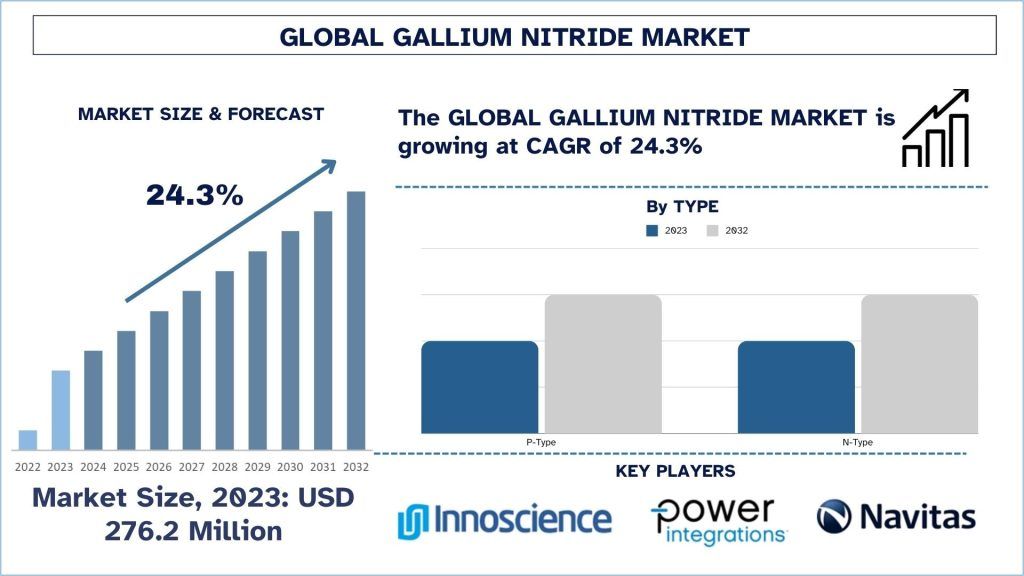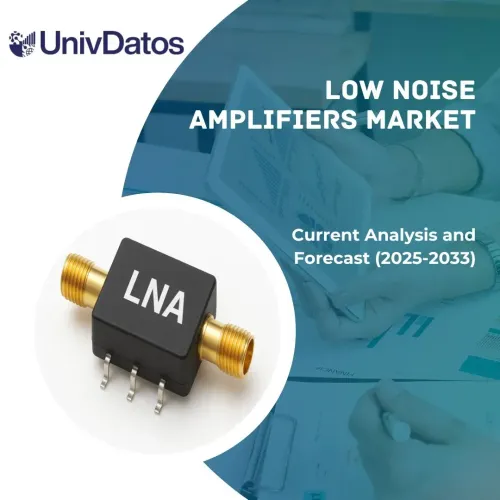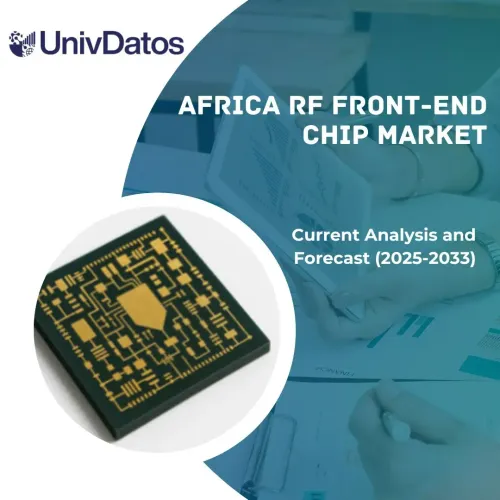- الرئيسية
- معلومات عنا
- صناعة
- الخدمات
- قراءة
- اتصل بنا
سوق نتريد الغاليوم: التحليل الحالي والتوقعات (2024-2032)
التركيز على النوع (النوع P والنوع N)؛ التطبيق (السيارات والتنقل، والإلكترونيات الاستهلاكية، والاتصالات والبنية التحتية، والتطبيقات الصناعية وغيرها)؛ المنطقة/الدولة.
حجم سوق نيتريد الغاليوم والتوقعات
بلغت قيمة سوق نيتريد الغاليوم 276.2 مليون دولار أمريكي في عام 2023 ومن المتوقع أن ينمو بمعدل نمو سنوي مركب قوي يبلغ حوالي 24.3٪ خلال الفترة المتوقعة (2024-2032) بسبب الاستخدام المتزايد في شركات الإلكترونيات الاستهلاكية والسيارات.
تحليل سوق نيتريد الغاليوم
يظهر نيتريد الغاليوم بسرعة كمادة حاسمة في سوق أشباه الموصلات، المشهورة بخصائصه الإلكترونية الفائقة مقارنة بالسيليكون التقليدي. يتم الاحتفاء بنيتريد الغاليوم بسبب حركية الإلكترون العالية، والتوصيل الحراري، والكفاءة، مما يجعله مثاليًا للتطبيقات عالية الطاقة وعالية التردد. وقد دفعت هذه الخصائص إلى اعتماده في مختلف الصناعات، بما في ذلك الاتصالات السلكية واللاسلكية والسيارات والإلكترونيات الاستهلاكية. الطلب على نيتريد الغاليوم قوي بشكل خاص في تطوير إلكترونيات الطاقة ومكبرات الترددات اللاسلكية ومصابيح LED، حيث توفر قدرته على العمل بجهود ودرجات حرارة أعلى دون تدهور تحسينات كبيرة في الأداء. مع استمرار الصناعات في دفع حدود الابتكار التكنولوجي، يستعد نيتريد الغاليوم للعب دور محوري في الجيل التالي من الأجهزة الإلكترونية، والمساهمة في كفاءة الطاقة والأداء المحسن.
يقود سوق نيتريد الغاليوم بشكل أساسي خصائصه المادية الفائقة التي تمكن تطبيقات عالية الأداء في مختلف القطاعات. أحد المحركات المهمة هو الطلب المتزايد على الإلكترونيات الموفرة للطاقة وعالية الطاقة. تسمح حركية الإلكترون العالية والتوصيل الحراري العالي لنيتريد الغاليوم بأجهزة طاقة أصغر وأكثر كفاءة يمكنها التعامل مع جهود وترددات أعلى من المكونات التقليدية القائمة على السيليكون. وهذا يجعل نيتريد الغاليوم خيارًا جذابًا لمحولات الطاقة ومكبرات الترددات اللاسلكية ومصابيح LED، مما يؤدي إلى اعتماد كبير في صناعات السيارات والاتصالات والإلكترونيات الاستهلاكية. إن الاتجاه المتزايد نحو الكهرباء في المركبات، إلى جانب الحاجة إلى حلول إدارة الطاقة الفعالة في الأجهزة الاستهلاكية، يزيد من دفع الطلب على التقنيات القائمة على نيتريد الغاليوم.
محرك حاسم آخر هو الاستثمار المتزايد في البنية التحتية لشبكات الجيل الخامس وأنظمة الاتصالات المتقدمة. إن قدرة نيتريد الغاليوم على العمل بترددات أعلى بكفاءة أكبر تجعله مثاليًا لمحطات قاعدة الجيل الخامس وتطبيقات الترددات اللاسلكية الأخرى. مع قيام شركات الاتصالات على مستوى العالم بنشر شبكات الجيل الخامس، أصبحت الحاجة إلى مكونات نيتريد الغاليوم، التي يمكن أن توفر أداءً وموثوقية أفضل في العمليات عالية التردد، أكثر وضوحًا. بالإضافة إلى ذلك، يعتمد قطاعا الدفاع والفضاء بشكل متزايد على تكنولوجيا نيتريد الغاليوم للرادار والاتصالات عبر الأقمار الصناعية نظرًا لصلابتها وقدرتها على توفير كثافة طاقة عالية. تؤكد هذه العوامل مجتمعة الأهمية الإستراتيجية لنيتريد الغاليوم في دفع الابتكار والكفاءة في مختلف الصناعات عالية التقنية.
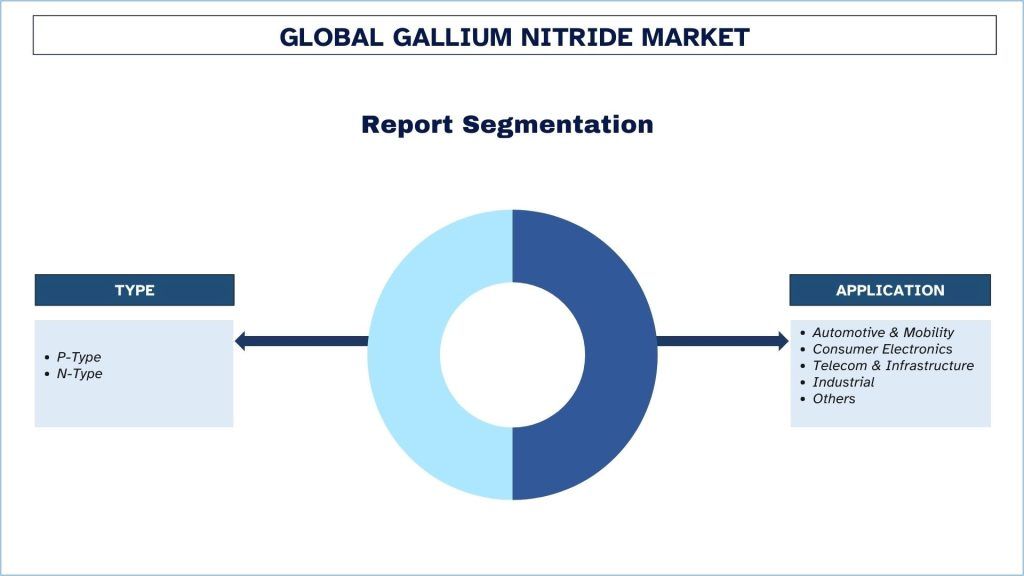
اتجاهات سوق نيتريد الغاليوم
يناقش هذا القسم اتجاهات السوق الرئيسية التي تؤثر على القطاعات المختلفة في سوق نيتريد الغاليوم كما حددها فريقنا من خبراء البحث.
كهربة السيارات
إن التحول نحو المركبات الكهربائية (EVs) يدفع بشكل كبير الطلب على إلكترونيات الطاقة القائمة على نيتريد الغاليوم. توفر ترانزستورات نيتريد الغاليوم كفاءة أعلى وسرعات تبديل أسرع وتقليل توليد الحرارة مقارنة بنظيراتها القائمة على السيليكون. هذه المزايا ضرورية في تطبيقات المركبات الكهربائية حيث تترجم كفاءة الطاقة بشكل مباشر إلى نطاقات قيادة أطول وأوقات شحن أسرع وأداء أفضل بشكل عام.
على سبيل المثال: تقوم شركة تويوتا، وهي شركة رائدة في تصنيع السيارات، بدمج تكنولوجيا نيتريد الغاليوم في محولات الطاقة والعاكسات الخاصة بها للمركبات الكهربائية. من خلال استخدام ترانزستورات نيتريد الغاليوم، تحقق تويوتا كفاءة أعلى في أنظمة إدارة الطاقة، مما يساعد على تمديد نطاق قيادة سياراتها الكهربائية وتقليل استهلاك الطاقة الإجمالي. يتماشى هذا الاعتماد مع اتجاه الصناعة الأوسع المتمثل في تعزيز أداء السيارة مع تعزيز الاستدامة.
تطورات الإلكترونيات الاستهلاكية
يعتمد سوق الإلكترونيات الاستهلاكية بشكل متزايد على تكنولوجيا نيتريد الغاليوم لتطوير مصادر طاقة وشواحن أصغر وأكثر كفاءة. تسمح حركية الإلكترون العالية والتوصيل الحراري العالي لنيتريد الغاليوم بتصميمات مدمجة مع مقاييس أداء أفضل، مما يجعلها مثالية للشواحن السريعة ومحولات الطاقة والأجهزة الإلكترونية المحمولة الأخرى.
على سبيل المثال: أطلقت Anker، وهي علامة تجارية شائعة في مجال الإلكترونيات الاستهلاكية، سلسلة من الشواحن السريعة القائمة على نيتريد الغاليوم والتي تعتبر أصغر حجمًا وأكثر كفاءة من الشواحن التقليدية القائمة على السيليكون. توفر شواحن نيتريد الغاليوم هذه أوقات شحن أسرع وتبديدًا أفضل للحرارة، مما يعزز راحة المستخدم وسلامة الجهاز. يؤكد نجاح شواحن نيتريد الغاليوم من Anker تفضيل المستهلك المتزايد للإكسسوارات الإلكترونية المدمجة وعالية الأداء.
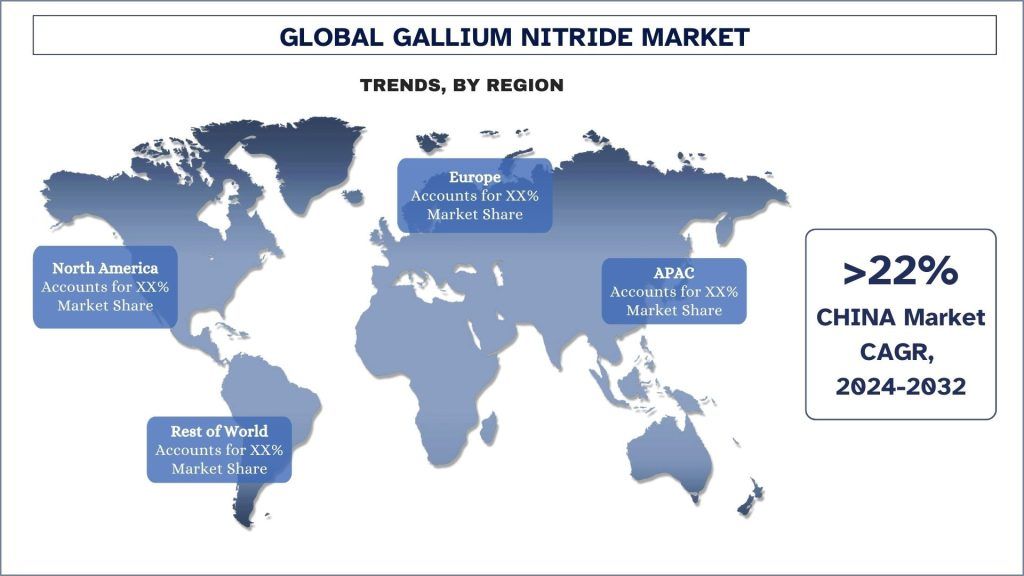
من المتوقع أن تنمو منطقة آسيا والمحيط الهادئ بمعدل نمو سنوي مركب كبير خلال الفترة المتوقعة
استحوذت منطقة آسيا والمحيط الهادئ على حصة كبيرة من سوق نيتريد الغاليوم في عام 2023. المحرك الرئيسي لسوق نيتريد الغاليوم في منطقة آسيا والمحيط الهادئ (APAC) هو التصنيع السريع والتقدم التكنولوجي في دول مثل الصين واليابان وكوريا الجنوبية. تعد هذه المنطقة موطنًا لكبرى الشركات المصنعة للإلكترونيات وأشباه الموصلات التي تستثمر بكثافة في تكنولوجيا نيتريد الغاليوم لتعزيز كفاءة وأداء منتجاتها. إن الاعتماد المتزايد للمركبات الكهربائية (EVs) وتوسيع البنية التحتية للطاقة المتجددة في منطقة آسيا والمحيط الهادئ يعزز بشكل كبير الطلب على إلكترونيات الطاقة عالية الكفاءة، حيث يلعب نيتريد الغاليوم من النوع N دورًا حاسمًا. علاوة على ذلك، فإن طرح شبكات الجيل الخامس والطلب المتزايد على أنظمة الاتصالات المتقدمة في هذه البلدان يدفع الحاجة إلى مكونات الترددات اللاسلكية عالية التردد وعالية الطاقة، مما يزيد من دفع سوق نيتريد الغاليوم. يساهم الدعم من المبادرات الحكومية والاستثمارات في تصنيع أشباه الموصلات والبحث أيضًا في النمو القوي لسوق نيتريد الغاليوم في منطقة آسيا والمحيط الهادئ.
نظرة عامة على صناعة نيتريد الغاليوم
سوق نيتريد الغاليوم تنافسي ومجزأ، مع وجود العديد من اللاعبين في السوق العالمية والدولية. يتبنى اللاعبون الرئيسيون استراتيجيات نمو مختلفة لتعزيز وجودهم في السوق، مثل الشراكات والاتفاقيات والتعاون وإطلاق المنتجات الجديدة والتوسعات الجغرافية وعمليات الاندماج والاستحواذ. تشمل بعض اللاعبين الرئيسيين العاملين في السوق Innoscience و Power Integration (PI) و Navitas Semiconductor و EPC و Infineon Technologies و Renesas و Texas Instruments و STMicroelectronics و Fujitsu Limited و Toshiba Corporation.
أخبار سوق نيتريد الغاليوم
مارس 2023، أعلنت Infineon و Gallium Nitride Systems أن الشركتين قد وقعتا اتفاقية نهائية بموجبها ستستحوذ Infineon على Gallium Nitride Systems مقابل 830 مليون دولار أمريكي. تم تمويل عملية الاستحواذ، وهي صفقة نقدية بالكامل، من السيولة الحالية.
مارس 2020، ستستحوذ STMicroelectronics على حصة الأغلبية في مبتكر نيتريد الغاليوم Exagan Nitride. ستعمل خبرة Exagan Nitride في مجال التجسيد وتطوير المنتجات والمعرفة التطبيقية على توسيع وتسريع خارطة طريق أعمال ST's Power Gallium Nitride لتطبيقات السيارات والصناعية والاستهلاكية. ستواصل Exagan Nitride تنفيذ خارطة طريق منتجاتها وسيتم دعمها من قبل ST في نشر منتجاتها.
تغطية تقرير سوق نيتريد الغاليوم
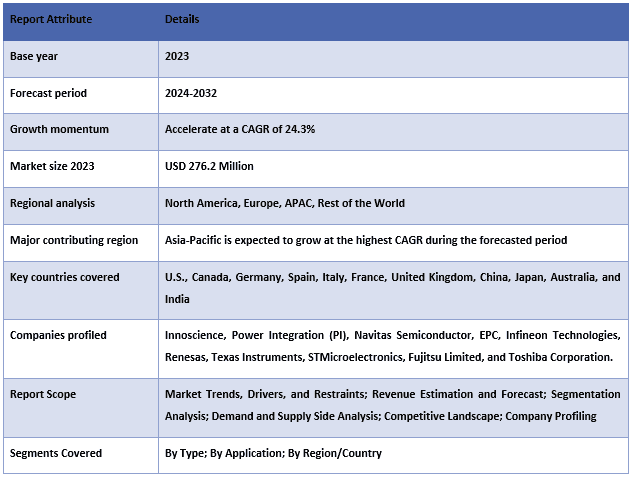
أسباب شراء هذا التقرير:
- تتضمن الدراسة تحليل تقدير حجم السوق والتنبؤ به الذي تم التحقق منه من قبل خبراء الصناعة الرئيسيين الموثوقين.
- يقدم التقرير مراجعة سريعة للأداء العام للصناعة في لمحة.
- يغطي التقرير تحليلًا متعمقًا لنظراء الصناعة البارزين مع التركيز الأساسي على البيانات المالية الرئيسية للأعمال ومحافظ المنتجات واستراتيجيات التوسع والتطورات الحديثة.
- فحص تفصيلي للدوافع والقيود والاتجاهات الرئيسية والفرص السائدة في الصناعة.
- تغطي الدراسة بشكل شامل السوق عبر قطاعات مختلفة.
- تحليل متعمق على المستوى الإقليمي للصناعة.
خيارات التخصيص:
يمكن تخصيص سوق نيتريد الغاليوم العالمي بشكل أكبر وفقًا للمتطلبات أو أي قطاع آخر من السوق. إلى جانب ذلك، تدرك UMI أن لديك احتياجات عمل خاصة بك، لذا لا تتردد في الاتصال بنا للحصول على تقرير يناسب متطلباتك تمامًا.
جدول المحتويات
منهجية البحث لتحليل سوق نتريد الغاليوم (2024-2032)
كان تحليل السوق التاريخية، وتقدير السوق الحالية، والتنبؤ بالسوق المستقبلية لسوق نتريد الغاليوم العالمي هي الخطوات الرئيسية الثلاث التي تم اتخاذها لإنشاء واستكشاف اعتماد نتريد الغاليوم في المناطق الرئيسية على مستوى العالم. تم إجراء بحث ثانوي شامل لجمع الأرقام التاريخية للسوق وتقدير حجم السوق الحالي. ثانيًا، تم أخذ العديد من النتائج والافتراضات في الاعتبار للتحقق من صحة هذه الرؤى. علاوة على ذلك، تم إجراء مقابلات أولية شاملة مع خبراء الصناعة عبر سلسلة القيمة لسوق نتريد الغاليوم العالمي. بعد افتراض أرقام السوق والتحقق من صحتها من خلال المقابلات الأولية، استخدمنا نهجًا تصاعديًا/تنازليًا للتنبؤ بحجم السوق الكامل. بعد ذلك، تم اعتماد طرق تقسيم السوق وتثليث البيانات لتقدير وتحليل حجم سوق القطاعات والقطاعات الفرعية في الصناعة. يتم شرح المنهجية التفصيلية أدناه:
تحليل حجم السوق التاريخية
الخطوة 1: دراسة متعمقة للمصادر الثانوية:
تم إجراء دراسة ثانوية مفصلة للحصول على حجم السوق التاريخية لنتريد الغاليوم من خلال مصادر داخلية للشركة مثل التقارير السنوية والبيانات المالية وعروض الأداء والنشرات الصحفية وما إلى ذلك، ومصادر خارجية بما في ذلك المجلات والأخبار والمقالات والمنشورات الحكومية ومنشورات المنافسين وتقارير القطاع وقاعدة بيانات الطرف الثالث والمنشورات الموثوقة الأخرى.
الخطوة 2: تقسيم السوق:
بعد الحصول على حجم السوق التاريخية لنتريد الغاليوم، أجرينا تحليلًا ثانويًا مفصلًا لجمع رؤى السوق التاريخية وحصتها للقطاعات والقطاعات الفرعية المختلفة للمناطق الرئيسية. يتم تضمين القطاعات الرئيسية في التقرير، مثل النوع والتطبيق. علاوة على ذلك، تم إجراء تحليلات على مستوى الدولة لتقييم الاعتماد الكلي لنماذج الاختبار في تلك المنطقة.
الخطوة 3: تحليل العوامل:
بعد الحصول على حجم السوق التاريخية للقطاعات والقطاعات الفرعية المختلفة، أجرينا تحليلًا تفصيليًا للعوامل لتقدير حجم السوق الحالي لنتريد الغاليوم. علاوة على ذلك، أجرينا تحليلًا للعوامل باستخدام متغيرات تابعة ومستقلة مثل نوع وتطبيق سوق نتريد الغاليوم. تم إجراء تحليل شامل لسيناريوهات جانب الطلب والعرض مع الأخذ في الاعتبار أهم الشراكات وعمليات الاندماج والاستحواذ والتوسع التجاري وإطلاق المنتجات في قطاع نتريد الغاليوم في جميع أنحاء العالم.
تقدير وتوقع حجم السوق الحالي
تحديد حجم السوق الحالي: بناءً على رؤى قابلة للتنفيذ من الخطوات الثلاث المذكورة أعلاه، توصلنا إلى حجم السوق الحالي واللاعبين الرئيسيين في سوق نتريد الغاليوم العالمي وحصص السوق للقطاعات. تم تحديد جميع التقسيمات المطلوبة للحصص المئوية وتقسيمات السوق باستخدام النهج الثانوي المذكور أعلاه وتم التحقق منها من خلال المقابلات الأولية.
التقدير والتنبؤ: لتقدير السوق والتنبؤ بها، تم تعيين أوزان لعوامل مختلفة بما في ذلك المحركات والاتجاهات والقيود والفرص المتاحة لأصحاب المصلحة. بعد تحليل هذه العوامل، تم تطبيق تقنيات التنبؤ ذات الصلة، أي النهج التصاعدي/التنازلي، للوصول إلى توقعات السوق لعام 2032 للقطاعات والقطاعات الفرعية المختلفة عبر الأسواق الرئيسية على مستوى العالم. تتضمن منهجية البحث المعتمدة لتقدير حجم السوق ما يلي:
- حجم سوق الصناعة، من حيث الإيرادات (بالدولار الأمريكي) ومعدل اعتماد نتريد الغاليوم عبر الأسواق الرئيسية محليًا
- جميع الحصص المئوية والتقسيمات والتوزيعات لقطاعات السوق والقطاعات الفرعية
- اللاعبون الرئيسيون في سوق نتريد الغاليوم العالمي من حيث المنتجات المعروضة. أيضًا، استراتيجيات النمو التي اعتمدها هؤلاء اللاعبون للتنافس في السوق سريع النمو
التحقق من صحة حجم السوق وحصته
البحث الأولي: تم إجراء مقابلات متعمقة مع قادة الرأي الرئيسيين (KOLs) بما في ذلك كبار المسؤولين التنفيذيين (CXO/VPs، رئيس المبيعات، رئيس التسويق، الرئيس التنفيذي للعمليات، الرئيس الإقليمي، رئيس الدولة، وما إلى ذلك) عبر المناطق الرئيسية. ثم تم تلخيص نتائج البحث الأولي، وإجراء تحليل إحصائي لإثبات الفرضية المذكورة. تم دمج المدخلات من البحث الأولي مع النتائج الثانوية، وبالتالي تحويل المعلومات إلى رؤى قابلة للتنفيذ.
تقسيم المشاركين الأساسيين في مناطق مختلفة
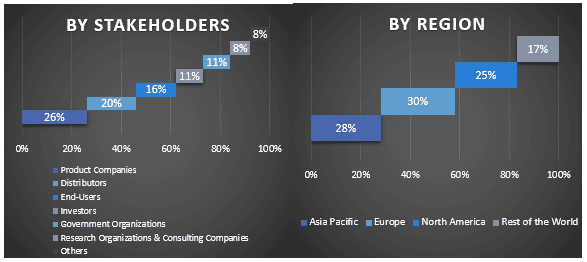
هندسة السوق
تم استخدام تقنية تثليث البيانات لإكمال تقدير السوق الإجمالي والوصول إلى أرقام إحصائية دقيقة لكل قطاع وقطاع فرعي من سوق نتريد الغاليوم العالمي. تم تقسيم البيانات إلى عدة قطاعات وقطاعات فرعية بعد دراسة مختلف المعلمات والاتجاهات في مجالات النوع والتطبيق في سوق نتريد الغاليوم العالمي.
الهدف الرئيسي من دراسة سوق نتريد الغاليوم العالمي
تم تحديد اتجاهات السوق الحالية والمستقبلية لسوق نتريد الغاليوم العالمي في الدراسة. يمكن للمستثمرين الحصول على رؤى استراتيجية لترسيخ تقديرهم للاستثمارات بناءً على التحليل النوعي والكمي الذي تم إجراؤه في الدراسة. حددت اتجاهات السوق الحالية والمستقبلية الجاذبية الإجمالية للسوق على المستوى الإقليمي، مما يوفر منصة للمشارك الصناعي لاستغلال السوق غير المستغلة للاستفادة من ميزة المحرك الأول. تشمل الأهداف الكمية الأخرى للدراسات ما يلي:
- تحليل حجم السوق الحالي والمتوقع لصناعة نتريد الغاليوم من حيث القيمة (بالدولار الأمريكي). أيضًا، قم بتحليل حجم السوق الحالي والمتوقع للقطاعات والقطاعات الفرعية المختلفة
- تشمل القطاعات في الدراسة مجالات النوع والتطبيق
- تحديد وتحليل الإطار التنظيمي لصناعة نتريد الغاليوم
- تحليل سلسلة القيمة المتضمنة في وجود وسطاء مختلفين، جنبًا إلى جنب مع تحليل سلوكيات العملاء والمنافسين في الصناعة
- تحليل حجم السوق الحالي والمتوقع لسوق نتريد الغاليوم للمنطقة الرئيسية
- تشمل الدول الرئيسية في المناطق التي تمت دراستها في التقرير آسيا والمحيط الهادئ وأوروبا وأمريكا الشمالية وبقية العالم
- ملفات تعريف الشركة لسوق نتريد الغاليوم واستراتيجيات النمو التي اعتمدها اللاعبون في السوق للاستمرار في السوق سريع النمو
- تحليل إقليمي متعمق للصناعة.
الأسئلة الشائعة الأسئلة الشائعة
س1: ما هو حجم السوق الحالي وإمكانات النمو لسوق نيتريد الغاليوم؟
س٢: ما هي العوامل الدافعة لنمو سوق نيتريد الغاليوم؟
س3: أي قطاع لديه الحصة الأكبر في سوق نيتريد الغاليوم حسب التطبيق؟
س4: ما هي التقنيات والاتجاهات الناشئة في سوق نيتريد الغاليوم؟
س5: أي منطقة ستسيطر على سوق نتريد الغاليوم؟
ذات صلة التقارير
العملاء الذين اشتروا هذا المنتج اشتروا أيضًا

